A Balanced Body Wins the Race
- Category: General
- Posted On:

Tips to Get You Off & Running This Spring
 Lindsay Zucco, a physical therapist demonstrates an exercise for runners during one of Fox Valley Orthopedics Running Clinics
Lindsay Zucco, a physical therapist demonstrates an exercise for runners during one of Fox Valley Orthopedics Running Clinics
Many people run for the sheer joy of it. Running inspires a sense of freedom, but it does place an enormous demand on your entire body…especially your legs and feet. Balance in your whole body will help you win the race.
“Maintaining proper structural balance in your body is the key to making it to the starting line healthy and race ready,” says Lindsay Zucco, a physical therapist at FVO.
In order to avoid problems with misaligned joints or tendons and muscles that have become irritated, inflamed, weak, and/or tight, Zucco recommends a variety of strengthening and lengthening exercises designed to balance the entire body:
Shin splint prevention
- Gastroc and soleus stretch to lengthen
- Toe taps to strengthen
Low back pain prevention
- Half kneeling hip flexor stretch to lengthen
- Plank core work to strengthen
Knee pain prevention
- Quad stretch, ITB (iliotibial band) foam rolling, to lengthen
- Side steps with tubing to strengthen
Shoulder impingement prevention
- Corner stretch to lengthen
- Rowing to strengthen
Zucco’s article, Maintaining Structural Balance, was recently published in the national runner’s publication Tri Magazine. For a complete description of the balancing exercises above download the PDF document.
In addition to a solid regimen of balancing exercises, avoiding problems such as Achilles and ankle problems, bursitis, shin splints, tendonitis and others requires a little foot TLC. FVO recommends starting the running season off right by putting footwear at the top of your runner’s ‘to do’ list:
- Know your foot type. A flat-footed runner has different needs than someone with high arches. Some running stores offer tests to help determine foot type and, by extension, shoe type.
- Consider your foot type, injury history, and specific needs when choosing shoes. For example, motion control running shoes are for runners requiring a stable shoe, or for those who’re flat-footed. And trail running shoes – with their knobby soles – are helpful for those who run on difficult surfaces.
- Provide cushioning and stability to your foot by selecting shoes with sufficient shock absorption qualities and solid shoe construction.
- Buy footwear late in the day when your foot is at its largest.
- Give yourself some wiggle room…ensure there’s a half an inch or so between the end of your longest toe and the end of your shoe.
- Replace your shoes every year. Shoes lose a lot of their oomph after 4 or 5 hundred miles or so of running.
- Alternate shoes to prevent wear and decrease foot stress.
- And remember to deal with injuries quickly. Many people miss out on summer marathons because they let persistent injuries go on for far too long. Consult an orthopedic specialist if you’re in any pain.



